All Exams >
SSC CHSL >
General Intelligence and Reasoning for SSC CHSL >
All Questions
All questions of Seating Arrangement for SSC CHSL Exam
PASSAGE -2
Six friends are sitting in a circle and are facing the centre of the circle. Deepa is between Prakash and Pankaj. Priti is between Mukesh and Lalit. Prakash and Mukesh are opposite to each other. Who is sitting opposite to Prakash ?
Who is sitting opposite to Priti ?
- a)Prakash
- b)Deepa
- c)Pankaj
- d)Lalit
Correct answer is option 'B'. Can you explain this answer?
PASSAGE -2
Six friends are sitting in a circle and are facing the centre of the circle. Deepa is between Prakash and Pankaj. Priti is between Mukesh and Lalit. Prakash and Mukesh are opposite to each other. Who is sitting opposite to Prakash ?
Who is sitting opposite to Priti ?
a)
Prakash
b)
Deepa
c)
Pankaj
d)
Lalit
|
|
Avinash Sharma answered |
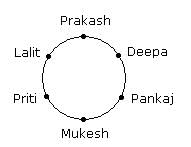
Hence, Deepa is sitting opposite to Priti.
A, P, R, X, S and Z are sitting in a row. S and Z are in the centre. A and P are at the ends. R is sitting to the left of A. Who is to the right of P ?
- a)A
- b)X
- c)S
- d)Z
Correct answer is option 'B'. Can you explain this answer?
a)
A
b)
X
c)
S
d)
Z

|
Nandini Rane answered |
According to question,
Draw a figure S and Z are in the centre, and A and P are at the ends. R is sitting on the left of A. Hence, X is on the right of P.
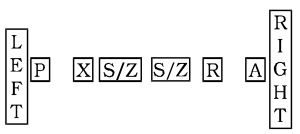
PASSAGE -1
Five girls are sitting on a bench to be photographed. Seema is to the left of Rani and to the right of Bindu. Mary is to the right of Rani. Reeta is between Rani and Mary.
Q. Who is sitting immediate right to Reeta?
- a)Bindu
- b)Rani
- c)Mary
- d)Seema
Correct answer is option 'C'. Can you explain this answer?
PASSAGE -1
Five girls are sitting on a bench to be photographed. Seema is to the left of Rani and to the right of Bindu. Mary is to the right of Rani. Reeta is between Rani and Mary.
Q. Who is sitting immediate right to Reeta?
Five girls are sitting on a bench to be photographed. Seema is to the left of Rani and to the right of Bindu. Mary is to the right of Rani. Reeta is between Rani and Mary.
Q. Who is sitting immediate right to Reeta?
a)
Bindu
b)
Rani
c)
Mary
d)
Seema

|
Arya Roy answered |
According to the given information, Seema is to the left of Rani and to the right of Bindu. This means that the order from left to right is: Bindu, Seema, Rani.
Mary is to the right of Rani. Therefore, the order from left to right is now: Bindu, Seema, Rani, Mary.
Reeta is between Rani and Mary. This means that Reeta is sitting between Rani and Mary. Therefore, the order from left to right is: Bindu, Seema, Rani, Reeta, Mary.
So, Mary is sitting immediate right to Reeta.
Mary is to the right of Rani. Therefore, the order from left to right is now: Bindu, Seema, Rani, Mary.
Reeta is between Rani and Mary. This means that Reeta is sitting between Rani and Mary. Therefore, the order from left to right is: Bindu, Seema, Rani, Reeta, Mary.
So, Mary is sitting immediate right to Reeta.
PASSAGE -1
Five girls are sitting on a bench to be photographed. Seema is to the left of Rani and to the right of Bindu. Mary is to the right of Rani. Reeta is between Rani and Mary.
Q. Who is second from the left in a photograph?
- a)Seema
- b)Mary
- c)Bindu
- d)Reeta
Correct answer is option 'D'. Can you explain this answer?
PASSAGE -1
Five girls are sitting on a bench to be photographed. Seema is to the left of Rani and to the right of Bindu. Mary is to the right of Rani. Reeta is between Rani and Mary.
Q. Who is second from the left in a photograph?
Five girls are sitting on a bench to be photographed. Seema is to the left of Rani and to the right of Bindu. Mary is to the right of Rani. Reeta is between Rani and Mary.
Q. Who is second from the left in a photograph?
a)
Seema
b)
Mary
c)
Bindu
d)
Reeta

|
Dhruv Mehra answered |

Reeta is sitting second from the left in photograph.
Directions to Solve In a class there are seven students (including boys and girls) A, B, C, D, E, F and G. They sit on three benches I, II and III. Such that at least two students on each bench and at least one girl on each bench. C who is a girl student, does not sit with A, E and D. F the boy student sits with only B. A sits on the bench I with his best friends. G sits on the bench III. E is the brother of C. Question - Which of the following is the group of girls ?- a)BAC
- b)BFC
- c)BCD
- d)CDF
Correct answer is option 'C'. Can you explain this answer?
Directions to Solve
In a class there are seven students (including boys and girls) A, B, C, D, E, F and G. They sit on three benches I, II and III. Such that at least two students on each bench and at least one girl on each bench. C who is a girl student, does not sit with A, E and D. F the boy student sits with only B. A sits on the bench I with his best friends. G sits on the bench III. E is the brother of C.
Question - Which of the following is the group of girls ?
a)
BAC
b)
BFC
c)
BCD
d)
CDF

|
Nandita Tiwari answered |
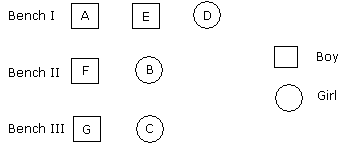
BCD are the group of girls.
Directions to Solve
Six girls are sitting in a circle facing to the centre of the circle. They are P, Q, R, S, T and V. T is not between Q and S but some other one. P is next to the left of V. R is 4th to the right of P.
Question -
Which of the following statement is not true ?
- a)S is just next to the right to R
- b)T is just next to the right of V
- c)R is second to the left of T
- d) P is second to the right of R
Correct answer is option 'C'. Can you explain this answer?
Directions to Solve
Six girls are sitting in a circle facing to the centre of the circle. They are P, Q, R, S, T and V. T is not between Q and S but some other one. P is next to the left of V. R is 4th to the right of P.
Question -
Which of the following statement is not true ?
a)
S is just next to the right to R
b)
T is just next to the right of V
c)
R is second to the left of T
d)
P is second to the right of R
|
|
Shalini Patel answered |
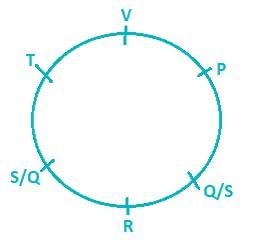
R is not second but fourth to the left of T.
Each of the 10 persons namely A, Q, R, Z, M, N, P, B, K and L are wearing a shirt. The colour of each shirt is one out of blue, green and red. There are ten chairs placed in a row. The chairs are consecutively numbered 1, 2, 3, 4...9 and 10 from left to right in that order. These ten persons have to sit on the chairs such that there is only one person in each chair. The number of persons wearing a green and a blue shirt is 2 and 3 respectively.Additional Information:
1. No two persons wearing blue shirts sit on consecutively numbered chairs.
2. Among the persons wearing red shirts, exactly three persons always are sitting together while the remaining two never.
3. A person wearing a blue shirt and a person wearing a green shirt never is sitting on consecutively numbered chairs.
4. A person wearing a green shirt cannot sit on chairs numbered 2 or 9.
5. Persons wearing red shirts are not sitting at extreme ends.The following table provides information about the six different seating arrangements namely I, II, III, IV, V and VI of the ten persons done by Mr. Crazy. He observed that out of all the seating arrangements done by him, there is one arrangement that is not consistent with the information stated under "Additional Information".
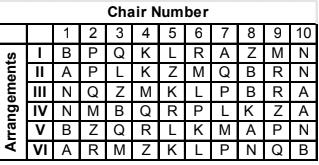 Q. Which of the following is not a permissible group of four persons such that the number of persons wearing a red, a green and a blue shirt is 2, 1 and 1 respectively?
Q. Which of the following is not a permissible group of four persons such that the number of persons wearing a red, a green and a blue shirt is 2, 1 and 1 respectively?- a)K, A, N and Z
- b)N, Q, K and Z
- c)A, P, L and R
- d)B, L, M and Q
Correct answer is option 'A'. Can you explain this answer?
Each of the 10 persons namely A, Q, R, Z, M, N, P, B, K and L are wearing a shirt. The colour of each shirt is one out of blue, green and red. There are ten chairs placed in a row. The chairs are consecutively numbered 1, 2, 3, 4...9 and 10 from left to right in that order. These ten persons have to sit on the chairs such that there is only one person in each chair. The number of persons wearing a green and a blue shirt is 2 and 3 respectively.
Additional Information:
1. No two persons wearing blue shirts sit on consecutively numbered chairs.
2. Among the persons wearing red shirts, exactly three persons always are sitting together while the remaining two never.
3. A person wearing a blue shirt and a person wearing a green shirt never is sitting on consecutively numbered chairs.
4. A person wearing a green shirt cannot sit on chairs numbered 2 or 9.
5. Persons wearing red shirts are not sitting at extreme ends.
1. No two persons wearing blue shirts sit on consecutively numbered chairs.
2. Among the persons wearing red shirts, exactly three persons always are sitting together while the remaining two never.
3. A person wearing a blue shirt and a person wearing a green shirt never is sitting on consecutively numbered chairs.
4. A person wearing a green shirt cannot sit on chairs numbered 2 or 9.
5. Persons wearing red shirts are not sitting at extreme ends.
The following table provides information about the six different seating arrangements namely I, II, III, IV, V and VI of the ten persons done by Mr. Crazy. He observed that out of all the seating arrangements done by him, there is one arrangement that is not consistent with the information stated under "Additional Information".

Q. Which of the following is not a permissible group of four persons such that the number of persons wearing a red, a green and a blue shirt is 2, 1 and 1 respectively?
a)
K, A, N and Z
b)
N, Q, K and Z
c)
A, P, L and R
d)
B, L, M and Q

|
Pankaj Chakraborty answered |
Let the people who wear a blue, red and green shirt be denoted by b, r and g respectively. Restrictions on the seating arrangement:
1. Two b’s must not be together.
2. Three r’s must be together.
3. A ‘b’ and a ‘g’ must not be together.
4. A ‘g’ cannot sit on a chair numbered 2 or 9.
1. Two b’s must not be together.
2. Three r’s must be together.
3. A ‘b’ and a ‘g’ must not be together.
4. A ‘g’ cannot sit on a chair numbered 2 or 9.
Case I: A person wearing a green shirt is sitting on chair numbered 1. It is only possible if another person wearing a green shirt sits on chair numbered 2, but this violates restriction number 4. Hence, this is also not possible.
Case II: A person wearing a blue shirt sits on chair numbered 1. The six seating arrangements that are possible are as follows.
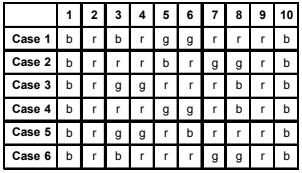
Now, we see that the cases 4, 5 and 6 are just obtained by reversing the cases 1, 2 and 3 respectively. It can be concluded that in any possible seating arrangement, the chairs numbered 1 and 10 are always occupied by people wearing blue shirts. It is given that the number of people wearing a blue shirt is 3. Looking at the table given in the question, we observe that in each of the six arrangements two out of the three different people i.e. A, B and N always sit on chairs numbered 1 and 10.
Hence it can be concluded that the people who wear a blue shirt are A, B and N From the given table the person wearing a blue shirt can never sit on chairs numbered 2, 4, 7 and 9. So, (in arrangement I), A, B and N sitting on chairs numbered 1, 7 and 10 is inconsistent. Also, the people wearing red shirts sit on chairs numbered 2 and 9 and in all the possible arrangements five different people namely P, Q, M, Z and R are sitting on chairs numbered either 2 or 9. Therefore, P, Q, M, Z and R are wearing red shirts and K and L are wearing green shirts.
Now, we see that the cases 4, 5 and 6 are just obtained by reversing the cases 1, 2 and 3 respectively. It can be concluded that in any possible seating arrangement, the chairs numbered 1 and 10 are always occupied by people wearing blue shirts. It is given that the number of people wearing a blue shirt is 3. Looking at the table given in the question, we observe that in each of the six arrangements two out of the three different people i.e. A, B and N always sit on chairs numbered 1 and 10.
Hence it can be concluded that the people who wear a blue shirt are A, B and N From the given table the person wearing a blue shirt can never sit on chairs numbered 2, 4, 7 and 9. So, (in arrangement I), A, B and N sitting on chairs numbered 1, 7 and 10 is inconsistent. Also, the people wearing red shirts sit on chairs numbered 2 and 9 and in all the possible arrangements five different people namely P, Q, M, Z and R are sitting on chairs numbered either 2 or 9. Therefore, P, Q, M, Z and R are wearing red shirts and K and L are wearing green shirts.
Option (1): A (Blue), P (Red), R (Red) and L (Green): Permissible
Option (2): N (Blue), Q (Red), K (Green) and Z (Red): Permissible
Option (3): K (Green), A (Blue), N (Blue) and Z (Red): Not Permissible
Option (4): B (Blue), L (Green), M (Red) and Q (Red): Permissible.
Option (2): N (Blue), Q (Red), K (Green) and Z (Red): Permissible
Option (3): K (Green), A (Blue), N (Blue) and Z (Red): Not Permissible
Option (4): B (Blue), L (Green), M (Red) and Q (Red): Permissible.
PASSAGE - 2
Read the following information carefully and answer the questions given below :
- P, Q, R, S, T, U and V are sitting around a circular table facing the centre
- R is next to the left of U and V is second to the left of R.
- P is sitting third to the left of T.
- Q is between S and T.
What is the position of U?
- a)To the immediate left of R
- b)Fourth to the right of S
- c)Between P and T
- d)To the immediate right of P
Correct answer is option 'B'. Can you explain this answer?
PASSAGE - 2
Read the following information carefully and answer the questions given below :
- P, Q, R, S, T, U and V are sitting around a circular table facing the centre
- R is next to the left of U and V is second to the left of R.
- P is sitting third to the left of T.
- Q is between S and T.
What is the position of U?
a)
To the immediate left of R
b)
Fourth to the right of S
c)
Between P and T
d)
To the immediate right of P
|
|
Vikas Kapoor answered |
We can arrange the persons in the following way.
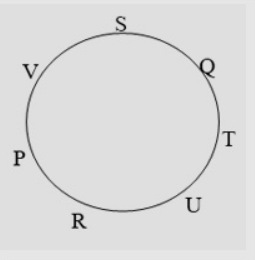
U is sitting fourth to the right of S.

U is sitting fourth to the right of S.
PASSAGE -2
Six friends are sitting in a circle and are facing the centre of the circle. Deepa is between Prakash and Pankaj. Priti is between Mukesh and Lalit. Prakash and Mukesh are opposite to each other.
Q. Who is just right to Pankaj?- a)Deepa
- b)Lalit
- c)Prakash
- d)Priti
Correct answer is option 'A'. Can you explain this answer?
PASSAGE -2
Six friends are sitting in a circle and are facing the centre of the circle. Deepa is between Prakash and Pankaj. Priti is between Mukesh and Lalit. Prakash and Mukesh are opposite to each other.
Q. Who is just right to Pankaj?
Six friends are sitting in a circle and are facing the centre of the circle. Deepa is between Prakash and Pankaj. Priti is between Mukesh and Lalit. Prakash and Mukesh are opposite to each other.
Q. Who is just right to Pankaj?
a)
Deepa
b)
Lalit
c)
Prakash
d)
Priti

|
Shruti Reddy answered |
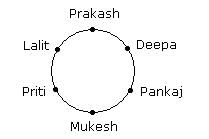
Hence, Deepa is sitting right to Pankaj
Directions to Solve Six friends are sitting in a circle and are facing the centre of the circle. Deepa is between Prakash and Pankaj. Priti is between Mukesh and Lalit. Prakash and Mukesh are opposite to each other. Question - Who are the neighbours of Mukesh ?- a)Prakash and Deepa
- b)Deepa and Priti
- c)Priti and Pankaj
- d)Lalit and Priti
Correct answer is option 'C'. Can you explain this answer?
Directions to Solve
Six friends are sitting in a circle and are facing the centre of the circle. Deepa is between Prakash and Pankaj. Priti is between Mukesh and Lalit. Prakash and Mukesh are opposite to each other.
Question - Who are the neighbours of Mukesh ?
a)
Prakash and Deepa
b)
Deepa and Priti
c)
Priti and Pankaj
d)
Lalit and Priti

|
Aniket Menon answered |
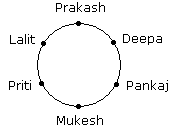
Hence, Priti and Pankaj are the neighbours of Mukesh.
Directions to Solve Six friends P, Q, R, S, T and U are sitting around the hexagonal table each at one corner and are facing the centre of the hexagonal. P is second to the left of U. Q is neighbour of R and S. T is second to the left of S. Question - Which one is sitting opposite to P ?- a)R
- b)Q
- c)T
- d)S
Correct answer is option 'D'. Can you explain this answer?
Directions to Solve
Six friends P, Q, R, S, T and U are sitting around the hexagonal table each at one corner and are facing the centre of the hexagonal. P is second to the left of U. Q is neighbour of R and S. T is second to the left of S.
Question - Which one is sitting opposite to P ?
a)
R
b)
Q
c)
T
d)
S

|
Shivam Malik answered |
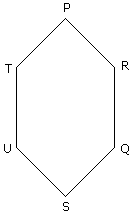
S is sitting opposite to P.
Directions to Solve A, B, C, D, E, F and G are sitting in a row facing North :- F is to the immediate right of E.
- E is 4th to the right of G.
- C is the neighbour of B and D.
- Person who is third to the left of D is at one of ends.
Question - What is the position of A ?- a)Between E and D
- b)Extreme left
- c)Centre
- d)Extreme right
Correct answer is option 'D'. Can you explain this answer?
Directions to Solve
A, B, C, D, E, F and G are sitting in a row facing North :
Question - - F is to the immediate right of E.
- E is 4th to the right of G.
- C is the neighbour of B and D.
- Person who is third to the left of D is at one of ends.
What is the position of A ?
a)
Between E and D
b)
Extreme left
c)
Centre
d)
Extreme right

|
Pranavi Dey answered |

A is in extreme right.
Directions to Solve In a class there are seven students (including boys and girls) A, B, C, D, E, F and G. They sit on three benches I, II and III. Such that at least two students on each bench and at least one girl on each bench. C who is a girl student, does not sit with A, E and D. F the boy student sits with only B. A sits on the bench I with his best friends. G sits on the bench III. E is the brother of C. Question - How many girls are there out of these 7 students ?- a)3
- b)3 or 4
- c)4
- d)Data inadequate
Correct answer is option 'B'. Can you explain this answer?
Directions to Solve
In a class there are seven students (including boys and girls) A, B, C, D, E, F and G. They sit on three benches I, II and III. Such that at least two students on each bench and at least one girl on each bench. C who is a girl student, does not sit with A, E and D. F the boy student sits with only B. A sits on the bench I with his best friends. G sits on the bench III. E is the brother of C.
Question - How many girls are there out of these 7 students ?
a)
3
b)
3 or 4
c)
4
d)
Data inadequate

|
Aarya Kumar answered |
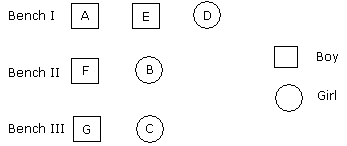
The number of girls is either 3 or 4.
Directions to Solve In a class there are seven students (including boys and girls) A, B, C, D, E, F and G. They sit on three benches I, II and III. Such that at least two students on each bench and at least one girl on each bench. C who is a girl student, does not sit with A, E and D. F the boy student sits with only B. A sits on the bench I with his best friends. G sits on the bench III. E is the brother of C. Question - Who sits with C ?- a)B
- b)D
- c)G
- d)E
Correct answer is option 'C'. Can you explain this answer?
Directions to Solve
In a class there are seven students (including boys and girls) A, B, C, D, E, F and G. They sit on three benches I, II and III. Such that at least two students on each bench and at least one girl on each bench. C who is a girl student, does not sit with A, E and D. F the boy student sits with only B. A sits on the bench I with his best friends. G sits on the bench III. E is the brother of C.
Question - Who sits with C ?
a)
B
b)
D
c)
G
d)
E

|
Kirti Kumar answered |

G sits with C.
PASSAGE -2
Six friends are sitting in a circle and... more are facing the centre of the circle. Deepa is between Prakash and Pankaj. Priti is between Mukesh and Lalit. Prakash and Mukesh are opposite to each other.
Who is sitting opposite to Prakash ?a)Mukeshb)Deepac)Pankaj d)LalitCorrect answer is option 'A'. Can you explain this answer?
|
|
Arun Khanna answered |

Can you explain the answer of this question below:PASSAGE -1
Five girls are sitting on a bench to be photographed. Seema is to the left of Rani and to the right of Bindu. Mary is to the right of Rani. Reeta is between Rani and Mary.
Who is in the middle of the photograph ?
- A:Bindu
- B:Rani
- C:Reeta
- D:Seema
The answer is B.
Five girls are sitting on a bench to be photographed. Seema is to the left of Rani and to the right of Bindu. Mary is to the right of Rani. Reeta is between Rani and Mary.
Who is in the middle of the photograph ?
|
|
Alok Verma answered |
The number of Girls are 5. They are seema, rani, reeta, mary and bindu
Seema is to the left of rani. So arrangement is:
⇒ Seema, ..., Rani
⇒ Seema, ..., Rani
Seema is to the to the right of bindu. So,arrangement is:
⇒ Bindhu , .. , Seema
⇒ Bindhu , .. , Seema
Mary is to the right of rani. So arrangement is:
⇒ Rani, ..., Mary
⇒ Rani, ..., Mary
Reeta is between rani and mary. So arrangement is:
⇒ Rani Reeta Mary
⇒ Rani Reeta Mary
So, the arrangement in photograph from left to right side is:-
Bindu , Seema , Rani , reeta and Mary
Bindu , Seema , Rani , reeta and Mary
These questions are based on the following information. P, Q, R, S and T sit around a table. P sits two seats to the left of R and Q sits two seats to the right of R.Q. Which of the following cannot be the correct seating arrangement of the five persons in either the clockwise direction or the anti-clockwise direction?- a)P, Q, R, S, T
- b)P, S, R, T, Q
- c)P, Q, S, R, T
- d)P, T, R, S, Q
- e)None of the above
Correct answer is option 'A'. Can you explain this answer?
These questions are based on the following information. P, Q, R, S and T sit around a table. P sits two seats to the left of R and Q sits two seats to the right of R.
Q. Which of the following cannot be the correct seating arrangement of the five persons in either the clockwise direction or the anti-clockwise direction?
a)
P, Q, R, S, T
b)
P, S, R, T, Q
c)
P, Q, S, R, T
d)
P, T, R, S, Q
e)
None of the above

|
Tanishq Shah answered |
P sits two seats to the left of R, and Q sits two seats to the right of R. We can represent this information in the diagram below.
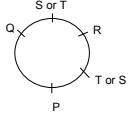
We will take each choice and see whether it fits in the arrangement that we represented through a diagram in the analysis of the data (the same diagram is reproduced below).
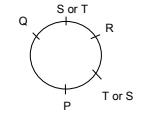
We can see that the arrangement given in choice (a) is not possible and hence the answer choice is (a).
We will take each choice and see whether it fits in the arrangement that we represented through a diagram in the analysis of the data (the same diagram is reproduced below).
We can see that the arrangement given in choice (a) is not possible and hence the answer choice is (a).
These questions are based on the following information. P, Q, R, S and T sit around a table. P sits two seats to the left of R and Q sits two seats to the right of R.Q. If S sits in between Q and R, who sits to the immediate right of P?- a)R
- b)S
- c)Q
- d)T
Correct answer is option 'D'. Can you explain this answer?
These questions are based on the following information. P, Q, R, S and T sit around a table. P sits two seats to the left of R and Q sits two seats to the right of R.
Q. If S sits in between Q and R, who sits to the immediate right of P?
a)
R
b)
S
c)
Q
d)
T

|
Prateek Datta answered |
P sits two seats to the left of R, and Q sits two seats to the right of R. We can represent this information in the diagram below.
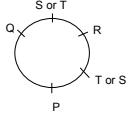
If S sits between Q and R, then the arrangement is as follows.
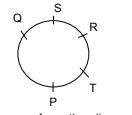
As can be seen from the diagram, T is to the immediate right of P. Choice (a)
If S sits between Q and R, then the arrangement is as follows.
As can be seen from the diagram, T is to the immediate right of P. Choice (a)
These questions are based on the following information. P, Q, R, S and T sit around a table. P sits two seats to the left of R and Q sits two seats to the right of R.Q. If a new person U joins the group such that the initial conditions for the seating arrangement should be observed and also a new condition that U does not sit next to R be satisfied, then which of the following statements is true?- a)U sits to the immediate right of S.
- b)U sits to the immediate left of T.
- c)U sits to the immediate left of P.
- d)Either (A) or (B) above.
- e)Q sits to the immediate right of U.
Correct answer is option 'C'. Can you explain this answer?
These questions are based on the following information. P, Q, R, S and T sit around a table. P sits two seats to the left of R and Q sits two seats to the right of R.
Q. If a new person U joins the group such that the initial conditions for the seating arrangement should be observed and also a new condition that U does not sit next to R be satisfied, then which of the following statements is true?
a)
U sits to the immediate right of S.
b)
U sits to the immediate left of T.
c)
U sits to the immediate left of P.
d)
Either (A) or (B) above.
e)
Q sits to the immediate right of U.

|
Varun Dasgupta answered |
P sits two seats to the left of R, and Q sits two seats to the right of R. We can represent this information in the diagram below.
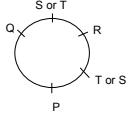
On the basis of the diagram that we drew, we find that to accommodate U we have to create a new slot between P and Q.
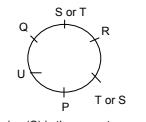
Hence, choice (c) is the correct answer. Choice (c)
On the basis of the diagram that we drew, we find that to accommodate U we have to create a new slot between P and Q.
Hence, choice (c) is the correct answer. Choice (c)
Directions to Solve Each of these questions are based on the information given below:- A ,B, C, D and E are five men sitting in a line facing to south - while M, N, O, P and Q are five ladies sitting in a second line parallel to the first line and are facing to North.
- B who is just next to the left of D, is opposite to Q.
- C and N are diagonally opposite to each other.
- E is opposite to O who is just next right of M.
- P who is just to the left of Q, is opposite to D.
- M is at one end of the line.
Question - If B shifts to the place of E, E shifts to the place of Q, and Q shifts to the place of B, then who will be the second to the left of the person opposite to O ?- a)Q
- b)P
- c)E
- d)D
Correct answer is option 'A'. Can you explain this answer?
Directions to Solve
Each of these questions are based on the information given below:
Question - - A ,B, C, D and E are five men sitting in a line facing to south - while M, N, O, P and Q are five ladies sitting in a second line parallel to the first line and are facing to North.
- B who is just next to the left of D, is opposite to Q.
- C and N are diagonally opposite to each other.
- E is opposite to O who is just next right of M.
- P who is just to the left of Q, is opposite to D.
- M is at one end of the line.
If B shifts to the place of E, E shifts to the place of Q, and Q shifts to the place of B, then who will be the second to the left of the person opposite to O ?
a)
Q
b)
P
c)
E
d)
D

|
Saranya Ahuja answered |
Given Information:
- 5 men (A, B, C, D, E) sitting in a line facing south
- 5 women (M, N, O, P, Q) sitting in a line facing north parallel to the first line
- B, who is just next to the left of D, is opposite to Q
- C and N are diagonally opposite to each other
- E is opposite to O who is just next right of M
- P, who is just to the left of Q, is opposite to D
- M is at one end of the line
Solution:
To solve this question, we need to redraw the diagram after the given changes and then find the person who will be second to the left of the person opposite to O.
New Diagram:
1. Before Changes:
- A B C D E (facing south)
- M N O P Q (facing north)
2. After Changes:
- A Q C B D E (facing south)
- M N E P O (facing north)
Answer:
According to the new diagram, we can see that:
- E is opposite to P
- Q is opposite to B
- O is opposite to C
Therefore, the person opposite to O is C and the person second to the left of C is Q. Hence, the correct answer is option A (Q).
- 5 men (A, B, C, D, E) sitting in a line facing south
- 5 women (M, N, O, P, Q) sitting in a line facing north parallel to the first line
- B, who is just next to the left of D, is opposite to Q
- C and N are diagonally opposite to each other
- E is opposite to O who is just next right of M
- P, who is just to the left of Q, is opposite to D
- M is at one end of the line
Solution:
To solve this question, we need to redraw the diagram after the given changes and then find the person who will be second to the left of the person opposite to O.
New Diagram:
1. Before Changes:
- A B C D E (facing south)
- M N O P Q (facing north)
2. After Changes:
- A Q C B D E (facing south)
- M N E P O (facing north)
Answer:
According to the new diagram, we can see that:
- E is opposite to P
- Q is opposite to B
- O is opposite to C
Therefore, the person opposite to O is C and the person second to the left of C is Q. Hence, the correct answer is option A (Q).
Directions to Solve Six friends P, Q, R, S, T and U are sitting around the hexagonal table each at one corner and are facing the centre of the hexagonal. P is second to the left of U. Q is neighbour of R and S. T is second to the left of S. Question - Which of the following are the neighbours of P ?- a)U and P
- b)T and R
- c)U and R
- d)Data inadequate
Correct answer is option 'B'. Can you explain this answer?
Directions to Solve
Six friends P, Q, R, S, T and U are sitting around the hexagonal table each at one corner and are facing the centre of the hexagonal. P is second to the left of U. Q is neighbour of R and S. T is second to the left of S.
Question - Which of the following are the neighbours of P ?
a)
U and P
b)
T and R
c)
U and R
d)
Data inadequate

|
Janhavi Nambiar answered |

T and R are the neighbours of P.
Directions to Solve Five girls are sitting on a bench to be photographed. Seema is to the left of Rani and to the right of Bindu. Mary is to the right of Rani. Reeta is between Rani and Mary. Question - Who is second from the right ?- a)Mary
- b)Rani
- c)Reeta
- d)Bindu
Correct answer is option 'C'. Can you explain this answer?
Directions to Solve
Five girls are sitting on a bench to be photographed. Seema is to the left of Rani and to the right of Bindu. Mary is to the right of Rani. Reeta is between Rani and Mary.
Question - Who is second from the right ?
a)
Mary
b)
Rani
c)
Reeta
d)
Bindu

|
Raghav Choudhary answered |
Explanation:
To solve this problem, we need to analyze the given information and determine the order in which the girls are sitting on the bench. Let's break down the given information step by step:
Step 1: Seema is to the left of Rani and to the right of Bindu.
This means that the order of the girls from left to right is Bindu, Seema, and Rani.
Step 2: Mary is to the right of Rani.
Since Rani is on the right end of the bench, Mary must be sitting to the right of Rani.
Step 3: Reeta is between Rani and Mary.
Since Mary is to the right of Rani, Reeta must be sitting between Rani and Mary.
Final arrangement:
Based on the given information, we can determine the following arrangement of the girls from left to right on the bench:
Bindu - Seema - Rani - Reeta - Mary
Answer:
According to the given arrangement, the girl who is second from the right is Reeta (option C).
To solve this problem, we need to analyze the given information and determine the order in which the girls are sitting on the bench. Let's break down the given information step by step:
Step 1: Seema is to the left of Rani and to the right of Bindu.
This means that the order of the girls from left to right is Bindu, Seema, and Rani.
Step 2: Mary is to the right of Rani.
Since Rani is on the right end of the bench, Mary must be sitting to the right of Rani.
Step 3: Reeta is between Rani and Mary.
Since Mary is to the right of Rani, Reeta must be sitting between Rani and Mary.
Final arrangement:
Based on the given information, we can determine the following arrangement of the girls from left to right on the bench:
Bindu - Seema - Rani - Reeta - Mary
Answer:
According to the given arrangement, the girl who is second from the right is Reeta (option C).
Directions to Solve Each of these questions are based on the information given below:- A ,B, C, D and E are five men sitting in a line facing to south - while M, N, O, P and Q are five ladies sitting in a second line parallel to the first line and are facing to North.
- B who is just next to the left of D, is opposite to Q.
- C and N are diagonally opposite to each other.
- E is opposite to O who is just next right of M.
- P who is just to the left of Q, is opposite to D.
- M is at one end of the line.
Question - If O and P, A and E and B and Q interchange their positions, then who will be the second person to the right of the person who is opposite to the person second of the right of P ?- a)D
- b)A
- c)E
- d)O
Correct answer is option 'B'. Can you explain this answer?
Directions to Solve
Each of these questions are based on the information given below:
Question - - A ,B, C, D and E are five men sitting in a line facing to south - while M, N, O, P and Q are five ladies sitting in a second line parallel to the first line and are facing to North.
- B who is just next to the left of D, is opposite to Q.
- C and N are diagonally opposite to each other.
- E is opposite to O who is just next right of M.
- P who is just to the left of Q, is opposite to D.
- M is at one end of the line.
If O and P, A and E and B and Q interchange their positions, then who will be the second person to the right of the person who is opposite to the person second of the right of P ?
a)
D
b)
A
c)
E
d)
O

|
Aditi Menon answered |
Old arrangement :
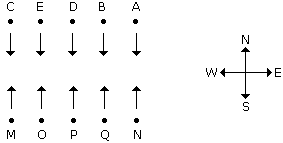
New arrangement :
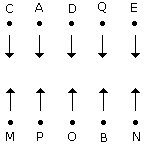
These questions are based on the following information. P, Q, R, S and T sit around a table. P sits two seats to the left of R and Q sits two seats to the right of R.Q. If S is not sitting next to Q, who is sitting between Q and S?- a)R
- b)P
- c)T
- d)Both (R) and (P)
- e)None of these
Correct answer is option 'B'. Can you explain this answer?
These questions are based on the following information. P, Q, R, S and T sit around a table. P sits two seats to the left of R and Q sits two seats to the right of R.
Q. If S is not sitting next to Q, who is sitting between Q and S?
a)
R
b)
P
c)
T
d)
Both (R) and (P)
e)
None of these

|
Harsh Choudhary answered |
P sits two seats to the left of R, and Q sits two seats to the right of R. We can represent this information in the diagram below.
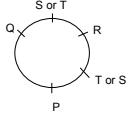
If S is not next to Q, then the seating arrangement is fixed as follows.
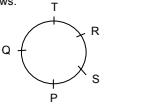
Now P is between Q and S. Choice (b)
If S is not next to Q, then the seating arrangement is fixed as follows.
Now P is between Q and S. Choice (b)
Directions to Solve Five girls are sitting on a bench to be photographed. Seema is to the left of Rani and to the right of Bindu. Mary is to the right of Rani. Reeta is between Rani and Mary. Question - Who is second from the left in photograph ?- a)Reeta
- b)Mary
- c)Bindu
- d)Seema
Correct answer is option 'D'. Can you explain this answer?
Directions to Solve
Five girls are sitting on a bench to be photographed. Seema is to the left of Rani and to the right of Bindu. Mary is to the right of Rani. Reeta is between Rani and Mary.
Question - Who is second from the left in photograph ?
a)
Reeta
b)
Mary
c)
Bindu
d)
Seema

|
Raghav Choudhary answered |
Explanation:
To solve this problem, we need to analyze the given information and determine the position of each girl on the bench.
Given Information:
- Seema is to the left of Rani and to the right of Bindu.
- Mary is to the right of Rani.
- Reeta is between Rani and Mary.
Let's break down the given information step by step:
Step 1:
- Seema is to the left of Rani and to the right of Bindu.
- This means that the order from left to right is Bindu, Seema, Rani.
Step 2:
- Mary is to the right of Rani.
- Since Rani is already seated, Mary will be seated to the right of Rani.
Step 3:
- Reeta is between Rani and Mary.
- Since Mary is to the right of Rani, Reeta will be seated between Rani and Mary.
Now, let's arrange the girls on the bench based on the given information:
Bindu - Seema - Rani - Reeta - Mary
The question asks us to find the girl who is second from the left in the photograph.
Answer:
- The girl who is second from the left in the photograph is Seema (Option D).
To solve this problem, we need to analyze the given information and determine the position of each girl on the bench.
Given Information:
- Seema is to the left of Rani and to the right of Bindu.
- Mary is to the right of Rani.
- Reeta is between Rani and Mary.
Let's break down the given information step by step:
Step 1:
- Seema is to the left of Rani and to the right of Bindu.
- This means that the order from left to right is Bindu, Seema, Rani.
Step 2:
- Mary is to the right of Rani.
- Since Rani is already seated, Mary will be seated to the right of Rani.
Step 3:
- Reeta is between Rani and Mary.
- Since Mary is to the right of Rani, Reeta will be seated between Rani and Mary.
Now, let's arrange the girls on the bench based on the given information:
Bindu - Seema - Rani - Reeta - Mary
The question asks us to find the girl who is second from the left in the photograph.
Answer:
- The girl who is second from the left in the photograph is Seema (Option D).
Directions to SolveSix friends are sitting in a circle and are facing the centre of the circle. Deepa is between Prakash and Pankaj. Priti is between Mukesh and Lalit. Prakash and Mukesh are opposite to each other.Question - Who is sitting right to Prakash ?- a)Mukesh
- b)Deepa
- c)Pankaj
- d)Lalit
Correct answer is option 'D'. Can you explain this answer?
Directions to Solve
Six friends are sitting in a circle and are facing the centre of the circle. Deepa is between Prakash and Pankaj. Priti is between Mukesh and Lalit. Prakash and Mukesh are opposite to each other.
Question -
Who is sitting right to Prakash ?
a)
Mukesh
b)
Deepa
c)
Pankaj
d)
Lalit

|
Nilotpal Khanna answered |
Explanation:
To solve this question, we need to analyze the given information and make deductions based on it. Let's break down the given information and solve the question step by step.
Given Information:
1. Six friends are sitting in a circle and facing the center.
2. Deepa is between Prakash and Pankaj.
3. Priti is between Mukesh and Lalit.
4. Prakash and Mukesh are opposite to each other.
Step 1: Determine the position of Prakash and Mukesh.
Since Prakash and Mukesh are opposite to each other, they must be sitting diametrically opposite in the circle.
Step 2: Determine the position of Deepa.
According to the given information, Deepa is sitting between Prakash and Pankaj. Since Prakash and Mukesh are opposite to each other, Deepa cannot be sitting next to Prakash. Therefore, Deepa must be sitting next to Pankaj.
Step 3: Determine the position of Priti and Lalit.
According to the given information, Priti is sitting between Mukesh and Lalit. Since Mukesh is sitting opposite to Prakash, Priti cannot be sitting next to Mukesh. Therefore, Priti must be sitting next to Lalit.
Step 4: Determine the position of the remaining friend.
Since all the other positions have been determined, the remaining friend must be sitting next to Prakash.
Final Answer:
Based on the deductions made, the friend sitting right to Prakash is Lalit. Therefore, option D - Lalit is the correct answer.
To solve this question, we need to analyze the given information and make deductions based on it. Let's break down the given information and solve the question step by step.
Given Information:
1. Six friends are sitting in a circle and facing the center.
2. Deepa is between Prakash and Pankaj.
3. Priti is between Mukesh and Lalit.
4. Prakash and Mukesh are opposite to each other.
Step 1: Determine the position of Prakash and Mukesh.
Since Prakash and Mukesh are opposite to each other, they must be sitting diametrically opposite in the circle.
Step 2: Determine the position of Deepa.
According to the given information, Deepa is sitting between Prakash and Pankaj. Since Prakash and Mukesh are opposite to each other, Deepa cannot be sitting next to Prakash. Therefore, Deepa must be sitting next to Pankaj.
Step 3: Determine the position of Priti and Lalit.
According to the given information, Priti is sitting between Mukesh and Lalit. Since Mukesh is sitting opposite to Prakash, Priti cannot be sitting next to Mukesh. Therefore, Priti must be sitting next to Lalit.
Step 4: Determine the position of the remaining friend.
Since all the other positions have been determined, the remaining friend must be sitting next to Prakash.
Final Answer:
Based on the deductions made, the friend sitting right to Prakash is Lalit. Therefore, option D - Lalit is the correct answer.
PASSAGE -2
Six friends are sitting in a circle and are facing the centre of the circle. Deepa is between Prakash and Pankaj. Priti is between Mukesh and Lalit. Prakash and Mukesh are opposite to each other. Who is sitting opposite to Prakash?
Q. Who are the neighbours of Mukesh?- a)Prakash and Deepa
- b)Deepa and Priti
- c)Priti and Pankaj
- d)Lalit and Priti
Correct answer is option 'C'. Can you explain this answer?
PASSAGE -2
Six friends are sitting in a circle and are facing the centre of the circle. Deepa is between Prakash and Pankaj. Priti is between Mukesh and Lalit. Prakash and Mukesh are opposite to each other. Who is sitting opposite to Prakash?
Q. Who are the neighbours of Mukesh?
Six friends are sitting in a circle and are facing the centre of the circle. Deepa is between Prakash and Pankaj. Priti is between Mukesh and Lalit. Prakash and Mukesh are opposite to each other. Who is sitting opposite to Prakash?
Q. Who are the neighbours of Mukesh?
a)
Prakash and Deepa
b)
Deepa and Priti
c)
Priti and Pankaj
d)
Lalit and Priti

|
Varun Rane answered |
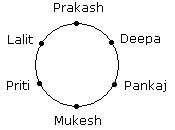
Hence, Priti and Pankaj are the neighbours of Mukesh.
Directions to Solve Six friends P, Q, R, S, T and U are sitting around the hexagonal table each at one corner and are facing the centre of the hexagonal. P is second to the left of U. Q is neighbour of R and S. T is second to the left of S. Question - Who is the fourth person to the left of Q ?- a)P
- b)U
- c)R
- d)Data inadequate
Correct answer is option 'A'. Can you explain this answer?
Directions to Solve
Six friends P, Q, R, S, T and U are sitting around the hexagonal table each at one corner and are facing the centre of the hexagonal. P is second to the left of U. Q is neighbour of R and S. T is second to the left of S.
Question - Who is the fourth person to the left of Q ?
a)
P
b)
U
c)
R
d)
Data inadequate

|
Anjali Nair answered |
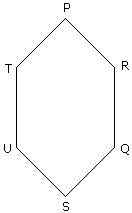
P is the fourth person to the left of Q.
Directions to Solve A, B, C, D, E, F and G are sitting in a row facing North :- F is to the immediate right of E.
- E is 4th to the right of G.
- C is the neighbour of B and D.
- Person who is third to the left of D is at one of ends.
Question - Which of the following statement is not true ?- a)E is to the immediate left of D
- b)A is at one of the ends
- c)G is to the immediate left of B
- d)F is second to the right of D
Correct answer is option 'A'. Can you explain this answer?
Directions to Solve
A, B, C, D, E, F and G are sitting in a row facing North :
Question - - F is to the immediate right of E.
- E is 4th to the right of G.
- C is the neighbour of B and D.
- Person who is third to the left of D is at one of ends.
Which of the following statement is not true ?
a)
E is to the immediate left of D
b)
A is at one of the ends
c)
G is to the immediate left of B
d)
F is second to the right of D

|
Debolina Sengupta answered |

Directions to Solve A, B, C, D, E, F and G are sitting in a row facing North :- F is to the immediate right of E.
- E is 4th to the right of G.
- C is the neighbour of B and D.
- Person who is third to the left of D is at one of ends.
Question - Who are the neighbours of B ?- a)C and D
- b)C and G
- c)G and F
- d)C and E
Correct answer is option 'B'. Can you explain this answer?
Directions to Solve
A, B, C, D, E, F and G are sitting in a row facing North :
Question - - F is to the immediate right of E.
- E is 4th to the right of G.
- C is the neighbour of B and D.
- Person who is third to the left of D is at one of ends.
Who are the neighbours of B ?
a)
C and D
b)
C and G
c)
G and F
d)
C and E

|
Manasa Chavan answered |

C and G are the neighbours of B.
Directions to Solve Each of these questions are based on the information given below :- 8 persons E, F, G, H, I, J, K and L are seated around a square table - two on each side.
- There are 3 ladies who are not seated next to each other.
- J is between L and F.
- G is between I and F.
- H, a lady member is second to the left of J.
- F, a male member is seated opposite to E, a lady member.
- There is a lady member between F and I.
Question - What is true about J and K ?- a)J is male, K is female
- b)J is female, K is male
- c)Both are female
- d)Both are male
Correct answer is option 'D'. Can you explain this answer?
Directions to Solve
Each of these questions are based on the information given below :
Question - - 8 persons E, F, G, H, I, J, K and L are seated around a square table - two on each side.
- There are 3 ladies who are not seated next to each other.
- J is between L and F.
- G is between I and F.
- H, a lady member is second to the left of J.
- F, a male member is seated opposite to E, a lady member.
- There is a lady member between F and I.
What is true about J and K ?
a)
J is male, K is female
b)
J is female, K is male
c)
Both are female
d)
Both are male

|
Aarya Kumar answered |

Both are male.
Directions to Solve Five girls are sitting on a bench to be photographed. Seema is to the left of Rani and to the right of Bindu. Mary is to the right of Rani. Reeta is between Rani and Mary. Question - Who is sitting immediate right to Reeta ?- a)Bindu
- b)Rani
- c)Mary
- d)Seema
Correct answer is option 'C'. Can you explain this answer?
Directions to Solve
Five girls are sitting on a bench to be photographed. Seema is to the left of Rani and to the right of Bindu. Mary is to the right of Rani. Reeta is between Rani and Mary.
Question - Who is sitting immediate right to Reeta ?
a)
Bindu
b)
Rani
c)
Mary
d)
Seema

|
Ankita Dey answered |
Given Information:
- Seema is to the left of Rani and to the right of Bindu.
- Mary is to the right of Rani.
- Reeta is between Rani and Mary.
Step 1: Visualize the seating arrangement
Let's represent the seating arrangement with the following diagram:
```
[ ] [Reeta] [ ] [Mary] [Rani] [Seema]
```
We know that Reeta is between Rani and Mary. So, Reeta is sitting between Rani and Mary.
Step 2: Analyze the given information
From the given information, we can deduce the following:
1. Seema is to the left of Rani and to the right of Bindu.
- This means that Seema is sitting between Bindu and Rani.
- The seating arrangement so far: `[ ] [ ] [ ] [ ] [Rani] [Seema]`
2. Mary is to the right of Rani.
- This means that Mary is sitting to the immediate right of Rani.
- The seating arrangement so far: `[ ] [ ] [ ] [Mary] [Rani] [Seema]`
3. Reeta is between Rani and Mary.
- This means that Reeta is sitting between Rani and Mary.
- The seating arrangement so far: `[ ] [Reeta] [ ] [Mary] [Rani] [Seema]`
Step 3: Answer the question
The question asks who is sitting immediately to the right of Reeta. From the seating arrangement, we can see that Mary is sitting immediately to the right of Reeta.
Conclusion:
Therefore, Mary is sitting immediately to the right of Reeta. The correct answer is option 'C'.
- Seema is to the left of Rani and to the right of Bindu.
- Mary is to the right of Rani.
- Reeta is between Rani and Mary.
Step 1: Visualize the seating arrangement
Let's represent the seating arrangement with the following diagram:
```
[ ] [Reeta] [ ] [Mary] [Rani] [Seema]
```
We know that Reeta is between Rani and Mary. So, Reeta is sitting between Rani and Mary.
Step 2: Analyze the given information
From the given information, we can deduce the following:
1. Seema is to the left of Rani and to the right of Bindu.
- This means that Seema is sitting between Bindu and Rani.
- The seating arrangement so far: `[ ] [ ] [ ] [ ] [Rani] [Seema]`
2. Mary is to the right of Rani.
- This means that Mary is sitting to the immediate right of Rani.
- The seating arrangement so far: `[ ] [ ] [ ] [Mary] [Rani] [Seema]`
3. Reeta is between Rani and Mary.
- This means that Reeta is sitting between Rani and Mary.
- The seating arrangement so far: `[ ] [Reeta] [ ] [Mary] [Rani] [Seema]`
Step 3: Answer the question
The question asks who is sitting immediately to the right of Reeta. From the seating arrangement, we can see that Mary is sitting immediately to the right of Reeta.
Conclusion:
Therefore, Mary is sitting immediately to the right of Reeta. The correct answer is option 'C'.
Directions to Solve In an Exhibition seven cars of different companies - Cadillac, Ambassador, Fiat, Maruti, Mercedes, Bedford and Fargo are standing facing to east in the following order :- Cadillac is next to right of Fargo.
- Fargo is fourth to the right of Fiat.
- Maruti car is between Ambassador and Bedford.
- Fiat which is third to the left of Ambassador, is at one end.
Question - Which of the cars are on both the sides of cadillac car ?- a)Ambassador and Maruti
- b)Maruti and Fiat
- c)Fargo and Mercedes
- d)Ambassador and Fargo
Correct answer is option 'C'. Can you explain this answer?
Directions to Solve
In an Exhibition seven cars of different companies - Cadillac, Ambassador, Fiat, Maruti, Mercedes, Bedford and Fargo are standing facing to east in the following order :
Question - - Cadillac is next to right of Fargo.
- Fargo is fourth to the right of Fiat.
- Maruti car is between Ambassador and Bedford.
- Fiat which is third to the left of Ambassador, is at one end.
Which of the cars are on both the sides of cadillac car ?
a)
Ambassador and Maruti
b)
Maruti and Fiat
c)
Fargo and Mercedes
d)
Ambassador and Fargo

|
Janhavi Nambiar answered |
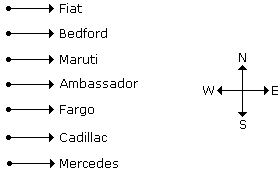
Fargo and Mercedes are on both the sides of cadillac car.
A supermarket has to place 12 items (coded A to L) in shelves numbered 1 to 16. Five of these items are types of biscuits, three are types of candies and the rest are types of savouries. Only one item can be kept in a shelf. Items are to be placed such that all items of same type are clustered together with no empty shelf between items of the same type and at least one empty shelf between two different types of items. At most two empty shelves can have consecutive numbers.
The following additional facts are known. - A and B are to be placed in consecutively numbered shelves in increasing order.
- I and J are to be placed in consecutively numbered shelves both higher numbered than the shelves in which A and B are kept.
- D, E and F are savouries and are to be placed in consecutively numbered shelves in increasing order after all the biscuits and candies.
- K is to be placed in shelf number 16.
- L and J are items of the same type, while H is an item of a different type.
- C is a candy and is to be placed in a shelf preceded by two empty shelves.
- L is to be placed in a shelf preceded by exactly one empty shelf.
Which of the following statements is necessarily true?- a)All biscuits are kept before candies.
- b)There are two empty shelves between the biscuits and the candies.
- c)There are at least four shelves between items B and C.
- d)All candies are kept before biscuits.
Correct answer is option 'C'. Can you explain this answer?
A supermarket has to place 12 items (coded A to L) in shelves numbered 1 to 16. Five of these items are types of biscuits, three are types of candies and the rest are types of savouries. Only one item can be kept in a shelf. Items are to be placed such that all items of same type are clustered together with no empty shelf between items of the same type and at least one empty shelf between two different types of items. At most two empty shelves can have consecutive numbers.
The following additional facts are known.
The following additional facts are known.
- A and B are to be placed in consecutively numbered shelves in increasing order.
- I and J are to be placed in consecutively numbered shelves both higher numbered than the shelves in which A and B are kept.
- D, E and F are savouries and are to be placed in consecutively numbered shelves in increasing order after all the biscuits and candies.
- K is to be placed in shelf number 16.
- L and J are items of the same type, while H is an item of a different type.
- C is a candy and is to be placed in a shelf preceded by two empty shelves.
- L is to be placed in a shelf preceded by exactly one empty shelf.
Which of the following statements is necessarily true?
a)
All biscuits are kept before candies.
b)
There are two empty shelves between the biscuits and the candies.
c)
There are at least four shelves between items B and C.
d)
All candies are kept before biscuits.
|
|
Pallavi khanna answered |
Explanation:
Given Information:
- A and B are placed in consecutively numbered shelves in increasing order.
- I and J are placed in consecutively numbered shelves higher than A and B.
- D, E, and F are savouries and are placed in consecutively numbered shelves after all biscuits and candies.
- K is placed in shelf number 16.
- L and J are of the same type.
- H is of a different type.
- C is a candy and is placed in a shelf preceded by two empty shelves.
- L is placed in a shelf preceded by one empty shelf.
Analysis:
- From the given information, we can determine the following:
- A and B are placed in shelves 1 and 2.
- I and J are placed in shelves higher than A and B.
- D, E, and F (savouries) are placed after all biscuits and candies.
- K is placed in shelf 16.
- C is placed in a shelf preceded by two empty shelves.
- L is placed in a shelf preceded by one empty shelf.
Necessarily True Statement:
- There are at least four shelves between items B and C.
- This is true because B is placed in shelf 2, and C is placed in a shelf preceded by two empty shelves. Therefore, there are at least four shelves between B and C, making option C the correct answer.
Given Information:
- A and B are placed in consecutively numbered shelves in increasing order.
- I and J are placed in consecutively numbered shelves higher than A and B.
- D, E, and F are savouries and are placed in consecutively numbered shelves after all biscuits and candies.
- K is placed in shelf number 16.
- L and J are of the same type.
- H is of a different type.
- C is a candy and is placed in a shelf preceded by two empty shelves.
- L is placed in a shelf preceded by one empty shelf.
Analysis:
- From the given information, we can determine the following:
- A and B are placed in shelves 1 and 2.
- I and J are placed in shelves higher than A and B.
- D, E, and F (savouries) are placed after all biscuits and candies.
- K is placed in shelf 16.
- C is placed in a shelf preceded by two empty shelves.
- L is placed in a shelf preceded by one empty shelf.
Necessarily True Statement:
- There are at least four shelves between items B and C.
- This is true because B is placed in shelf 2, and C is placed in a shelf preceded by two empty shelves. Therefore, there are at least four shelves between B and C, making option C the correct answer.
PASSAGE -1
Five girls are sitting on a bench to be photographed. Seema is to the left of Rani and to the right of Bindu. Mary is to the right of Rani. Reeta is between Rani and Mary.
Who is second from the right ?
- a)Mary
- b)Rani
- c)Reeta
- d)Bindu
Correct answer is option 'C'. Can you explain this answer?
PASSAGE -1
Five girls are sitting on a bench to be photographed. Seema is to the left of Rani and to the right of Bindu. Mary is to the right of Rani. Reeta is between Rani and Mary.
Who is second from the right ?
a)
Mary
b)
Rani
c)
Reeta
d)
Bindu

|
Ishani Rane answered |

A, B, C, D and E are sitting on a bench. A is sitting next to B, C is sitting next to D, D is not sitting with E who is on the left end of the bench. C is on the second position from the right. A is to the right of B and E. A and C are sitting together. In which position A is sitting ?- a)Between B and D
- b)Between B and C
- c)Between E and D
- d)Between C and E
Correct answer is option 'B'. Can you explain this answer?
A, B, C, D and E are sitting on a bench. A is sitting next to B, C is sitting next to D, D is not sitting with E who is on the left end of the bench. C is on the second position from the right. A is to the right of B and E. A and C are sitting together. In which position A is sitting ?
a)
Between B and D
b)
Between B and C
c)
Between E and D
d)
Between C and E

|
Snehal Nambiar answered |

Therefore, A is sitting in between B and C.
Directions to Solve Six girls are sitting in a circle facing to the centre of the circle. They are P, Q, R, S, T and V. T is not between Q and S but some other one. P is next to the left of V. R is 4th to the right of P. Question - If P and R interchange their positions then which of the following pair will sit together ?- a)RT
- b)PV
- c)VT
- d)QV
Correct answer is option 'C'. Can you explain this answer?
Directions to Solve
Six girls are sitting in a circle facing to the centre of the circle. They are P, Q, R, S, T and V. T is not between Q and S but some other one. P is next to the left of V. R is 4th to the right of P.
Question - If P and R interchange their positions then which of the following pair will sit together ?
a)
RT
b)
PV
c)
VT
d)
QV

|
Harshitha Desai answered |
After changing the position of P and R

V and T are together.
Directions to Solve Each of these questions are based on the information given below:- A ,B, C, D and E are five men sitting in a line facing to south - while M, N, O, P and Q are five ladies sitting in a second line parallel to the first line and are facing to North.
- B who is just next to the left of D, is opposite to Q.
- C and N are diagonally opposite to each other.
- E is opposite to O who is just next right of M.
- P who is just to the left of Q, is opposite to D.
- M is at one end of the line.
Question - Which of the following pair is diagonally opposite to each other ?- a)EQ
- b)BO
- c)AN
- d)AM
Correct answer is option 'D'. Can you explain this answer?
Directions to Solve
Each of these questions are based on the information given below:
Question - - A ,B, C, D and E are five men sitting in a line facing to south - while M, N, O, P and Q are five ladies sitting in a second line parallel to the first line and are facing to North.
- B who is just next to the left of D, is opposite to Q.
- C and N are diagonally opposite to each other.
- E is opposite to O who is just next right of M.
- P who is just to the left of Q, is opposite to D.
- M is at one end of the line.
Which of the following pair is diagonally opposite to each other ?
a)
EQ
b)
BO
c)
AN
d)
AM

|
Rajdeep Ghoshal answered |
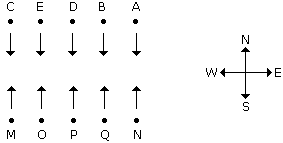
Directions to Solve In an Exhibition seven cars of different companies - Cadillac, Ambassador, Fiat, Maruti, Mercedes, Bedford and Fargo are standing facing to east in the following order :- Cadillac is next to right of Fargo.
- Fargo is fourth to the right of Fiat.
- Maruti car is between Ambassador and Bedford.
- Fiat which is third to the left of Ambassador, is at one end.
Question - Which of the following statement is correct ?- a)Maruti is next left of Ambassador.
- b)Bedford is next left of Fiat.
- c)Bedford is at one end.
- d)Fiat is next second to the right of Maruti.
Correct answer is option 'A'. Can you explain this answer?
Directions to Solve
In an Exhibition seven cars of different companies - Cadillac, Ambassador, Fiat, Maruti, Mercedes, Bedford and Fargo are standing facing to east in the following order :
Question - - Cadillac is next to right of Fargo.
- Fargo is fourth to the right of Fiat.
- Maruti car is between Ambassador and Bedford.
- Fiat which is third to the left of Ambassador, is at one end.
Which of the following statement is correct ?
a)
Maruti is next left of Ambassador.
b)
Bedford is next left of Fiat.
c)
Bedford is at one end.
d)
Fiat is next second to the right of Maruti.

|
Atharva Khanna answered |
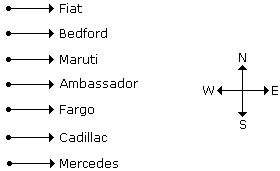
Therefore, Maruti is next left of Ambassador.
These questions are based on the following information. P, Q, R, S and T sit around a table. P sits two seats to the left of R and Q sits two seats to the right of R.Q. If a new person U joins the group such that the initial conditions for the seating arrangement should be observed and also a new condition that U does not sit next to P, S or T be satisfied, then who will be the neighbours of P (one on either side)?- a)T and Q
- b)S and Q
- c)T and R
- d)R and Q
- e)S and T
Correct answer is option 'E'. Can you explain this answer?
These questions are based on the following information. P, Q, R, S and T sit around a table. P sits two seats to the left of R and Q sits two seats to the right of R.
Q. If a new person U joins the group such that the initial conditions for the seating arrangement should be observed and also a new condition that U does not sit next to P, S or T be satisfied, then who will be the neighbours of P (one on either side)?
a)
T and Q
b)
S and Q
c)
T and R
d)
R and Q
e)
S and T

|
Deepika Banerjee answered |
P sits two seats to the left of R, and Q sits two seats to the right of R. We can represent this information in the diagram below.
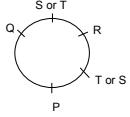
We create a new slot for the sixth person. But since U will not sit next to P, S or T, he will have to sit between R and Q. The arrangement will then look as follows:
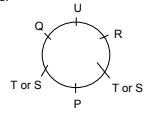
As we can see from the diagram, the neighbours of P will be T and S.
We create a new slot for the sixth person. But since U will not sit next to P, S or T, he will have to sit between R and Q. The arrangement will then look as follows:
As we can see from the diagram, the neighbours of P will be T and S.
Each of the 10 persons namely A, Q, R, Z, M, N, P, B, K and L are wearing a shirt. The colour of each shirt is one out of blue, green and red. There are ten chairs placed in a row. The chairs are consecutively numbered 1, 2, 3, 4...9 and 10 from left to right in that order. These ten persons have to sit on the chairs such that there is only one person in each chair. The number of persons wearing a green and a blue shirt is 2 and 3 respectively.Additional Information:
1. No two persons wearing blue shirts sit on consecutively numbered chairs.
2. Among the persons wearing red shirts, exactly three persons always are sitting together while the remaining two never.
3. A person wearing a blue shirt and a person wearing a green shirt never is sitting on consecutively numbered chairs.
4. A person wearing a green shirt cannot sit on chairs numbered 2 or 9.
5. Persons wearing red shirts are not sitting at extreme ends.The following table provides information about the six different seating arrangements namely I, II, III, IV, V and VI of the ten persons done by Mr. Crazy. He observed that out of all the seating arrangements done by him, there is one arrangement that is not consistent with the information stated under "Additional Information".
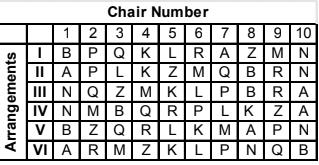 Q. Which of the following persons is wearing a green shirt?
Q. Which of the following persons is wearing a green shirt?- a)A
- b)K
- c)R
- d)P
Correct answer is option 'B'. Can you explain this answer?
Each of the 10 persons namely A, Q, R, Z, M, N, P, B, K and L are wearing a shirt. The colour of each shirt is one out of blue, green and red. There are ten chairs placed in a row. The chairs are consecutively numbered 1, 2, 3, 4...9 and 10 from left to right in that order. These ten persons have to sit on the chairs such that there is only one person in each chair. The number of persons wearing a green and a blue shirt is 2 and 3 respectively.
Additional Information:
1. No two persons wearing blue shirts sit on consecutively numbered chairs.
2. Among the persons wearing red shirts, exactly three persons always are sitting together while the remaining two never.
3. A person wearing a blue shirt and a person wearing a green shirt never is sitting on consecutively numbered chairs.
4. A person wearing a green shirt cannot sit on chairs numbered 2 or 9.
5. Persons wearing red shirts are not sitting at extreme ends.
1. No two persons wearing blue shirts sit on consecutively numbered chairs.
2. Among the persons wearing red shirts, exactly three persons always are sitting together while the remaining two never.
3. A person wearing a blue shirt and a person wearing a green shirt never is sitting on consecutively numbered chairs.
4. A person wearing a green shirt cannot sit on chairs numbered 2 or 9.
5. Persons wearing red shirts are not sitting at extreme ends.
The following table provides information about the six different seating arrangements namely I, II, III, IV, V and VI of the ten persons done by Mr. Crazy. He observed that out of all the seating arrangements done by him, there is one arrangement that is not consistent with the information stated under "Additional Information".

Q. Which of the following persons is wearing a green shirt?
a)
A
b)
K
c)
R
d)
P

|
Tanishq Sengupta answered |
Let the people who wear a blue, red and green shirt be denoted by b, r and g respectively. Restrictions on the seating arrangement:
1. Two b’s must not be together.
2. Three r’s must be together.
3. A ‘b’ and a ‘g’ must not be together.
4. A ‘g’ cannot sit on a chair numbered 2 or 9.
1. Two b’s must not be together.
2. Three r’s must be together.
3. A ‘b’ and a ‘g’ must not be together.
4. A ‘g’ cannot sit on a chair numbered 2 or 9.
Case I: A person wearing a green shirt is sitting on chair numbered 1. It is only possible if another person wearing a green shirt sits on chair numbered 2, but this violates restriction number 4. Hence, this is also not possible.
Case II: A person wearing a blue shirt sits on chair numbered 1. The six seating arrangements that are possible are as follows.
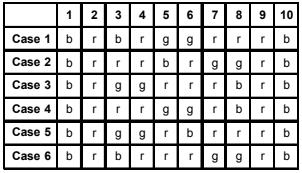
Now, we see that the cases 4, 5 and 6 are just obtained by reversing the cases 1, 2 and 3 respectively. It can be concluded that in any possible seating arrangement, the chairs numbered 1 and 10 are always occupied by people wearing blue shirts. It is given that the number of people wearing a blue shirt is 3. Looking at the table given in the question, we observe that in each of the six arrangements two out of the three different people i.e. A, B and N always sit on chairs numbered 1 and 10.
Hence it can be concluded that the people who wear a blue shirt are A, B and N From the given table the person wearing a blue shirt can never sit on chairs numbered 2, 4, 7 and 9. So, (in arrangement I), A, B and N sitting on chairs numbered 1, 7 and 10 is inconsistent. Also, the people wearing red shirts sit on chairs numbered 2 and 9 and in all the possible arrangements five different people namely P, Q, M, Z and R are sitting on chairs numbered either 2 or 9. Therefore, P, Q, M, Z and R are wearing red shirts and K and L are wearing green shirts. K and L are wearing green shirts. Hence, K is the answer.
Now, we see that the cases 4, 5 and 6 are just obtained by reversing the cases 1, 2 and 3 respectively. It can be concluded that in any possible seating arrangement, the chairs numbered 1 and 10 are always occupied by people wearing blue shirts. It is given that the number of people wearing a blue shirt is 3. Looking at the table given in the question, we observe that in each of the six arrangements two out of the three different people i.e. A, B and N always sit on chairs numbered 1 and 10.
Hence it can be concluded that the people who wear a blue shirt are A, B and N From the given table the person wearing a blue shirt can never sit on chairs numbered 2, 4, 7 and 9. So, (in arrangement I), A, B and N sitting on chairs numbered 1, 7 and 10 is inconsistent. Also, the people wearing red shirts sit on chairs numbered 2 and 9 and in all the possible arrangements five different people namely P, Q, M, Z and R are sitting on chairs numbered either 2 or 9. Therefore, P, Q, M, Z and R are wearing red shirts and K and L are wearing green shirts. K and L are wearing green shirts. Hence, K is the answer.
Directions to SolveEach of these questions are based on the information given below: - A ,B, C, D and E are five men sitting in a line facing to south - while M, N, O, P and Q are five ladies sitting in a second line parallel to the first line and are facing to North.
- B who is just next to the left of D, is opposite to Q.
- C and N are diagonally opposite to each other.
- E is opposite to O who is just next right of M.
- P who is just to the left of Q, is opposite to D.
- M is at one end of the line.
Question - In the original arrangement who is sitting just opposite to N?- a)B
- b)A
- c)C
- d)D
Correct answer is option 'B'. Can you explain this answer?
Directions to Solve
Each of these questions are based on the information given below:
- A ,B, C, D and E are five men sitting in a line facing to south - while M, N, O, P and Q are five ladies sitting in a second line parallel to the first line and are facing to North.
- B who is just next to the left of D, is opposite to Q.
- C and N are diagonally opposite to each other.
- E is opposite to O who is just next right of M.
- P who is just to the left of Q, is opposite to D.
- M is at one end of the line.
Question - In the original arrangement who is sitting just opposite to N?
a)
B
b)
A
c)
C
d)
D

|
Pankaj Nambiar answered |
Directions to Solve In a class there are seven students (including boys and girls) A, B, C, D, E, F and G. They sit on three benches I, II and III. Such that at least two students on each bench and at least one girl on each bench. C who is a girl student, does not sit with A, E and D. F the boy student sits with only B. A sits on the bench I with his best friends. G sits on the bench III. E is the brother of C. Question - On which bench there are three students ?- a)Bench I
- b)Bench II
- c)Bench III
- d)Bench I or II
Correct answer is option 'A'. Can you explain this answer?
Directions to Solve
In a class there are seven students (including boys and girls) A, B, C, D, E, F and G. They sit on three benches I, II and III. Such that at least two students on each bench and at least one girl on each bench. C who is a girl student, does not sit with A, E and D. F the boy student sits with only B. A sits on the bench I with his best friends. G sits on the bench III. E is the brother of C.
Question - On which bench there are three students ?
a)
Bench I
b)
Bench II
c)
Bench III
d)
Bench I or II

|
Neha Ahuja answered |
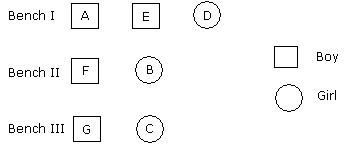
There are three students in Bench I.
Directions to Solve Six friends are sitting in a circle and are facing the centre of the circle. Deepa is between Prakash and Pankaj. Priti is between Mukesh and Lalit. Prakash and Mukesh are opposite to each other. Question - Who is just right to Pankaj ?- a)Deepa
- b)Lalit
- c)Prakash
- d)Priti
Correct answer is option 'A'. Can you explain this answer?
Directions to Solve
Six friends are sitting in a circle and are facing the centre of the circle. Deepa is between Prakash and Pankaj. Priti is between Mukesh and Lalit. Prakash and Mukesh are opposite to each other.
Question - Who is just right to Pankaj ?
a)
Deepa
b)
Lalit
c)
Prakash
d)
Priti

|
Aditi Menon answered |
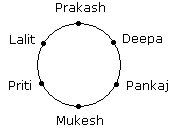
Hence, Deepa is sitting just right to Pankaj.
Each of the 10 persons namely A, Q, R, Z, M, N, P, B, K and L are wearing a shirt. The colour of each shirt is one out of blue, green and red. There are ten chairs placed in a row. The chairs are consecutively numbered 1, 2, 3, 4...9 and 10 from left to right in that order. These ten persons have to sit on the chairs such that there is only one person in each chair. The number of persons wearing a green and a blue shirt is 2 and 3 respectively.Additional Information:
1. No two persons wearing blue shirts sit on consecutively numbered chairs.
2. Among the persons wearing red shirts, exactly three persons always are sitting together while the remaining two never.
3. A person wearing a blue shirt and a person wearing a green shirt never is sitting on consecutively numbered chairs.
4. A person wearing a green shirt cannot sit on chairs numbered 2 or 9.
5. Persons wearing red shirts are not sitting at extreme ends.The following table provides information about the six different seating arrangements namely I, II, III, IV, V and VI of the ten persons done by Mr. Crazy. He observed that out of all the seating arrangements done by him, there is one arrangement that is not consistent with the information stated under "Additional Information".
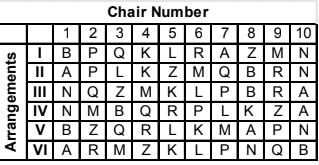 Q. Which of the arrangements done by Mr. Crazy is not consistent with the information stated under "Additional Information"?
Q. Which of the arrangements done by Mr. Crazy is not consistent with the information stated under "Additional Information"?- a)VI
- b)I
- c)III
- d)V
Correct answer is option 'B'. Can you explain this answer?
Each of the 10 persons namely A, Q, R, Z, M, N, P, B, K and L are wearing a shirt. The colour of each shirt is one out of blue, green and red. There are ten chairs placed in a row. The chairs are consecutively numbered 1, 2, 3, 4...9 and 10 from left to right in that order. These ten persons have to sit on the chairs such that there is only one person in each chair. The number of persons wearing a green and a blue shirt is 2 and 3 respectively.
Additional Information:
1. No two persons wearing blue shirts sit on consecutively numbered chairs.
2. Among the persons wearing red shirts, exactly three persons always are sitting together while the remaining two never.
3. A person wearing a blue shirt and a person wearing a green shirt never is sitting on consecutively numbered chairs.
4. A person wearing a green shirt cannot sit on chairs numbered 2 or 9.
5. Persons wearing red shirts are not sitting at extreme ends.
1. No two persons wearing blue shirts sit on consecutively numbered chairs.
2. Among the persons wearing red shirts, exactly three persons always are sitting together while the remaining two never.
3. A person wearing a blue shirt and a person wearing a green shirt never is sitting on consecutively numbered chairs.
4. A person wearing a green shirt cannot sit on chairs numbered 2 or 9.
5. Persons wearing red shirts are not sitting at extreme ends.
The following table provides information about the six different seating arrangements namely I, II, III, IV, V and VI of the ten persons done by Mr. Crazy. He observed that out of all the seating arrangements done by him, there is one arrangement that is not consistent with the information stated under "Additional Information".

Q. Which of the arrangements done by Mr. Crazy is not consistent with the information stated under "Additional Information"?
a)
VI
b)
I
c)
III
d)
V

|
Shivam Menon answered |
Let the people who wear a blue, red and green shirt be denoted by b, r and g respectively. Restrictions on the seating arrangement:
1. Two b’s must not be together.
2. Three r’s must be together.
3. A ‘b’ and a ‘g’ must not be together.
4. A ‘g’ cannot sit on a chair numbered 2 or 9.
1. Two b’s must not be together.
2. Three r’s must be together.
3. A ‘b’ and a ‘g’ must not be together.
4. A ‘g’ cannot sit on a chair numbered 2 or 9.
Case I: A person wearing a green shirt is sitting on chair numbered 1. It is only possible if another person wearing a green shirt sits on chair numbered 2, but this violates restriction number 4. Hence, this is also not possible.
Case II: A person wearing a blue shirt sits on chair numbered 1. The six seating arrangements that are possible are as follows.
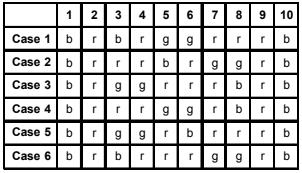
Now, we see that the cases 4, 5 and 6 are just obtained by reversing the cases 1, 2 and 3 respectively. It can be concluded that in any possible seating arrangement, the chairs numbered 1 and 10 are always occupied by people wearing blue shirts. It is given that the number of people wearing a blue shirt is 3. Looking at the table given in the question, we observe that in each of the six arrangements two out of the three different people i.e. A, B and N always sit on chairs numbered 1 and 10.
Hence it can be concluded that the people who wear a blue shirt are A, B and N From the given table the person wearing a blue shirt can never sit on chairs numbered 2, 4, 7 and 9. So, (in arrangement I), A, B and N sitting on chairs numbered 1, 7 and 10 is inconsistent. Also, the people wearing red shirts sit on chairs numbered 2 and 9 and in all the possible arrangements five different people namely P, Q, M, Z and R are sitting on chairs numbered either 2 or 9. Therefore, P, Q, M, Z and R are wearing red shirts and K and L are wearing green shirts. (a) I arrangement is not consistent.
Now, we see that the cases 4, 5 and 6 are just obtained by reversing the cases 1, 2 and 3 respectively. It can be concluded that in any possible seating arrangement, the chairs numbered 1 and 10 are always occupied by people wearing blue shirts. It is given that the number of people wearing a blue shirt is 3. Looking at the table given in the question, we observe that in each of the six arrangements two out of the three different people i.e. A, B and N always sit on chairs numbered 1 and 10.
Hence it can be concluded that the people who wear a blue shirt are A, B and N From the given table the person wearing a blue shirt can never sit on chairs numbered 2, 4, 7 and 9. So, (in arrangement I), A, B and N sitting on chairs numbered 1, 7 and 10 is inconsistent. Also, the people wearing red shirts sit on chairs numbered 2 and 9 and in all the possible arrangements five different people namely P, Q, M, Z and R are sitting on chairs numbered either 2 or 9. Therefore, P, Q, M, Z and R are wearing red shirts and K and L are wearing green shirts. (a) I arrangement is not consistent.
Directions to Solve In an Exhibition seven cars of different companies - Cadillac, Ambassador, Fiat, Maruti, Mercedes, Bedford and Fargo are standing facing to east in the following order :- Cadillac is next to right of Fargo.
- Fargo is fourth to the right of Fiat.
- Maruti car is between Ambassador and Bedford.
- Fiat which is third to the left of Ambassador, is at one end.
Question - Which of the following groups of cars is to the right of Ambassador ?- a)Cadillac, Fargo and Maruti
- b)Mercedes, Cadillac and Fargo
- c)Maruti, Bedford and Fiat
- d)Bedford, Cadillac and Fargo
Correct answer is option 'B'. Can you explain this answer?
Directions to Solve
In an Exhibition seven cars of different companies - Cadillac, Ambassador, Fiat, Maruti, Mercedes, Bedford and Fargo are standing facing to east in the following order :
Question - - Cadillac is next to right of Fargo.
- Fargo is fourth to the right of Fiat.
- Maruti car is between Ambassador and Bedford.
- Fiat which is third to the left of Ambassador, is at one end.
Which of the following groups of cars is to the right of Ambassador ?
a)
Cadillac, Fargo and Maruti
b)
Mercedes, Cadillac and Fargo
c)
Maruti, Bedford and Fiat
d)
Bedford, Cadillac and Fargo

|
Alok Sen answered |
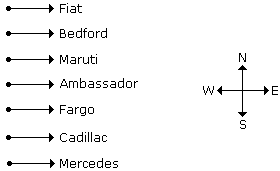
Mercedes, Cadillac and Fargo cars are to the right of Ambassador.
Directions to Solve Each of these questions are based on the information given below:- A ,B, C, D and E are five men sitting in a line facing to south - while M, N, O, P and Q are five ladies sitting in a second line parallel to the first line and are facing to North.
- B who is just next to the left of D, is opposite to Q.
- C and N are diagonally opposite to each other.
- E is opposite to O who is just next right of M.
- P who is just to the left of Q, is opposite to D.
- M is at one end of the line.
Question - Who is sitting third to the right of O ?- a)Q
- b)N
- c)M
- d)Data inadequate
Correct answer is option 'B'. Can you explain this answer?
Directions to Solve
Each of these questions are based on the information given below:
Question - - A ,B, C, D and E are five men sitting in a line facing to south - while M, N, O, P and Q are five ladies sitting in a second line parallel to the first line and are facing to North.
- B who is just next to the left of D, is opposite to Q.
- C and N are diagonally opposite to each other.
- E is opposite to O who is just next right of M.
- P who is just to the left of Q, is opposite to D.
- M is at one end of the line.
Who is sitting third to the right of O ?
a)
Q
b)
N
c)
M
d)
Data inadequate

|
Kajal Kulkarni answered |
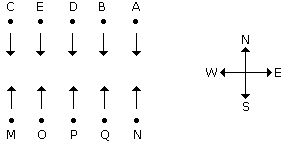
Eight persons P, Q, R, S, T, U, V and W are sitting around a circular table facing the center (not necessarily in the same order). Two persons sit between Q and W. V sits immediate left of W. Three persons sit between S and T. R sits immediate left of T. U is not the neighbor of P. One person sits between P and Q.Which of the following statement is correct?- a) Q sits to the immediate right of U.
- b)One person sits between P and R.
- c) Three persons sit between Q and R.
- d)One person sits between S and U.
Correct answer is option 'D'. Can you explain this answer?
Eight persons P, Q, R, S, T, U, V and W are sitting around a circular table facing the center (not necessarily in the same order). Two persons sit between Q and W. V sits immediate left of W. Three persons sit between S and T. R sits immediate left of T. U is not the neighbor of P. One person sits between P and Q.
Which of the following statement is correct?
a)
Q sits to the immediate right of U.
b)
One person sits between P and R.
c)
Three persons sit between Q and R.
d)
One person sits between S and U.

|
Glance Learning Institute answered |
Eight persons: P, Q, R, S, T, U, V and W.
1) Three persons sit between S and T.
2) R sits immediate left of T.
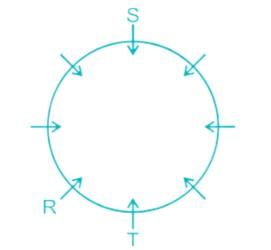
3) One person sits between P and Q.
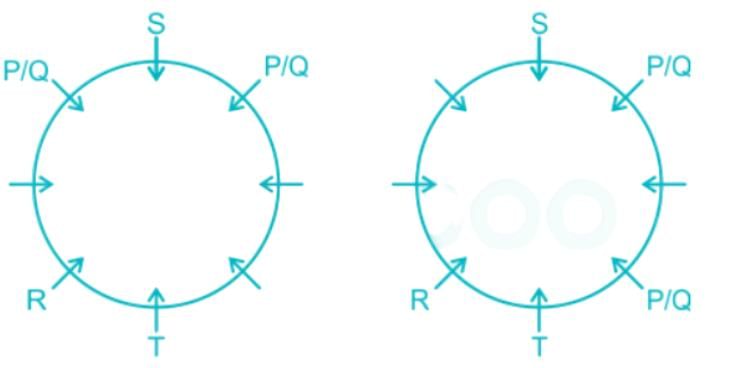
4) Two persons sit between Q and W.
5) V sits immediate left of W.
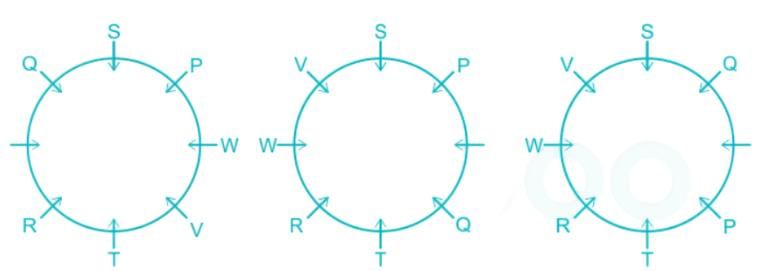
6) U is not the neighbor of P.
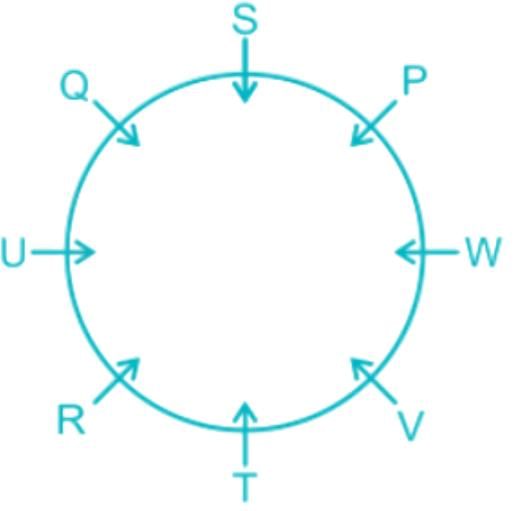
Checking o[tions one by one;
1) Q sits to the immediate right of U → False
2) One person sits between P and R → False
3) Three persons sit between Q and R → False
4) One person sits between S and U → True
Hence, option D is the correct answer.
A supermarket has to place 12 items (coded A to L) in shelves numbered 1 to 16. Five of these items are types of biscuits, three are types of candies and the rest are types of savouries. Only one item can be kept in a shelf. Items are to be placed such that all items of same type are clustered together with no empty shelf between items of the same type and at least one empty shelf between two different types of items. At most two empty shelves can have consecutive numbers.
The following additional facts are known. - A and B are to be placed in consecutively numbered shelves in increasing order.
- I and J are to be placed in consecutively numbered shelves both higher numbered than the shelves in which A and B are kept.
- D, E and F are savouries and are to be placed in consecutively numbered shelves in increasing order after all the biscuits and candies.
- K is to be placed in shelf number 16.
- L and J are items of the same type, while H is an item of a different type.
- C is a candy and is to be placed in a shelf preceded by two empty shelves.
- L is to be placed in a shelf preceded by exactly one empty shelf.
In how many different ways can the items be arranged on the shelves?- a)8
- b)1
- c)2
- d)4
Correct answer is option 'A'. Can you explain this answer?
A supermarket has to place 12 items (coded A to L) in shelves numbered 1 to 16. Five of these items are types of biscuits, three are types of candies and the rest are types of savouries. Only one item can be kept in a shelf. Items are to be placed such that all items of same type are clustered together with no empty shelf between items of the same type and at least one empty shelf between two different types of items. At most two empty shelves can have consecutive numbers.
The following additional facts are known.
The following additional facts are known.
- A and B are to be placed in consecutively numbered shelves in increasing order.
- I and J are to be placed in consecutively numbered shelves both higher numbered than the shelves in which A and B are kept.
- D, E and F are savouries and are to be placed in consecutively numbered shelves in increasing order after all the biscuits and candies.
- K is to be placed in shelf number 16.
- L and J are items of the same type, while H is an item of a different type.
- C is a candy and is to be placed in a shelf preceded by two empty shelves.
- L is to be placed in a shelf preceded by exactly one empty shelf.
In how many different ways can the items be arranged on the shelves?
a)
8
b)
1
c)
2
d)
4

|
Impact Learning answered |
There are 5 types of biscuits, 3 types of candies and 4 types of savouries. Among 16 shelves, there are 4 empty shelves.
It is given that all items of same type are clustered together with no empty shelf between items of the same type.
From (3) and (4), it can be concluded that D, E, F and K are savouries.
From (2) and (5), L, I and J are of one type and H is the other type. Therefore from (6), as C is a candy, L, I J must be types of biscuits and H is a type of candy. Now using (1), we can conclude that A and B are of one type but not candies as there are only 3 types of candies.
Therefore,
Biscuits: A, B, I, J, L Candies: C, H, G Savouries: D, E, F, K
From (3), (4), (6) and (7), there shelf number 12 must be an empty shelf. Also, D, E, F and K are placed in shelves numbered 13, 14, 15 and 16 respectively.
Now from (1), (2) and (7), the sequence (from left to right) in which biscuits are kept is:
(Empty shelf), L, A, B, (I/J), (J/I).
From (6), the candies must be in the following order: (Empty shelf), (Empty shelf), C, (H/G), (G/H)
Thus, we have


In each case, J and I can be arranged in 2 ways and G and H can be arranged among them in 2 ways. Thus, 2 × 2 = 4 ways.
Total number of ways the items can be arranged on the shelves = 4 + 4 = 8
Directions to Solve Six friends P, Q, R, S, T and U are sitting around the hexagonal table each at one corner and are facing the centre of the hexagonal. P is second to the left of U. Q is neighbour of R and S. T is second to the left of S. Question - Which one is sitting opposite to T ?- a)R
- b)Q
- c)Cannot be determined
- d)S
Correct answer is option 'B'. Can you explain this answer?
Directions to Solve
Six friends P, Q, R, S, T and U are sitting around the hexagonal table each at one corner and are facing the centre of the hexagonal. P is second to the left of U. Q is neighbour of R and S. T is second to the left of S.
Question - Which one is sitting opposite to T ?
a)
R
b)
Q
c)
Cannot be determined
d)
S

|
Aniket Menon answered |

Q is sitting opposite to T.
Chapter doubts & questions for Seating Arrangement - General Intelligence and Reasoning for SSC CHSL 2025 is part of SSC CHSL exam preparation. The chapters have been prepared according to the SSC CHSL exam syllabus. The Chapter doubts & questions, notes, tests & MCQs are made for SSC CHSL 2025 Exam. Find important definitions, questions, notes, meanings, examples, exercises, MCQs and online tests here.
Chapter doubts & questions of Seating Arrangement - General Intelligence and Reasoning for SSC CHSL in English & Hindi are available as part of SSC CHSL exam.
Download more important topics, notes, lectures and mock test series for SSC CHSL Exam by signing up for free.
General Intelligence and Reasoning for SSC CHSL
13 videos|18 docs|29 tests
|

Contact Support
Our team is online on weekdays between 10 AM - 7 PM
Typical reply within 3 hours
|
Free Exam Preparation
at your Fingertips!
Access Free Study Material - Test Series, Structured Courses, Free Videos & Study Notes and Prepare for Your Exam With Ease

 Join the 10M+ students on EduRev
Join the 10M+ students on EduRev
|

|
Create your account for free
OR
Forgot Password
OR
Signup to see your scores
go up
within 7 days!
within 7 days!
Takes less than 10 seconds to signup









